My Six-Week Learning Journey Through International Business Strategy
VerifiedAdded on 2024/05/20
|13
|3598
|53
AI Summary
This six-week learning journey through International Business Strategy (IBS) delves into the complexities of global business operations. The author explores key concepts, models, and frameworks, including the Uppsala Model, PESTLE analysis, SWOT analysis, Porter's generic five force model, and Ansoff's matrix. The journey highlights the importance of adapting strategies to evolving markets, analyzing macro and industry levels, and understanding the interplay of internal and external factors. The author also examines entry mode strategies, headquarter strategies, and the role of shareholder and stakeholder perspectives in shaping responsible business practices. This comprehensive exploration provides valuable insights into the dynamic world of international business strategy.
Contribute Materials
Your contribution can guide someone’s learning journey. Share your
documents today.

Contents
MY SIX-WEEK LEARNING JOURNEY THROUGH INTERNATIONAL BUSINESS STRATEGY..................2
REFERENCES.....................................................................................................................................6
APPENDIX 1......................................................................................................................................8
“THE SOCIAL RESPONSIBILITY OF BUSINESS IS TO INCREASE ITS PROFITS”................................8
APPENDIX 2....................................................................................................................................10
DIFFERENT FORMS OF AGENCY AND INSTITUTIONAL INFLUENCES WITHIN MULTINATIONAL
ENTREPRISES..............................................................................................................................10
APPENDIX 3....................................................................................................................................12
HOW INDUSTRIES EVOLVE.............................................................................................................12
1
MY SIX-WEEK LEARNING JOURNEY THROUGH INTERNATIONAL BUSINESS STRATEGY..................2
REFERENCES.....................................................................................................................................6
APPENDIX 1......................................................................................................................................8
“THE SOCIAL RESPONSIBILITY OF BUSINESS IS TO INCREASE ITS PROFITS”................................8
APPENDIX 2....................................................................................................................................10
DIFFERENT FORMS OF AGENCY AND INSTITUTIONAL INFLUENCES WITHIN MULTINATIONAL
ENTREPRISES..............................................................................................................................10
APPENDIX 3....................................................................................................................................12
HOW INDUSTRIES EVOLVE.............................................................................................................12
1
Secure Best Marks with AI Grader
Need help grading? Try our AI Grader for instant feedback on your assignments.
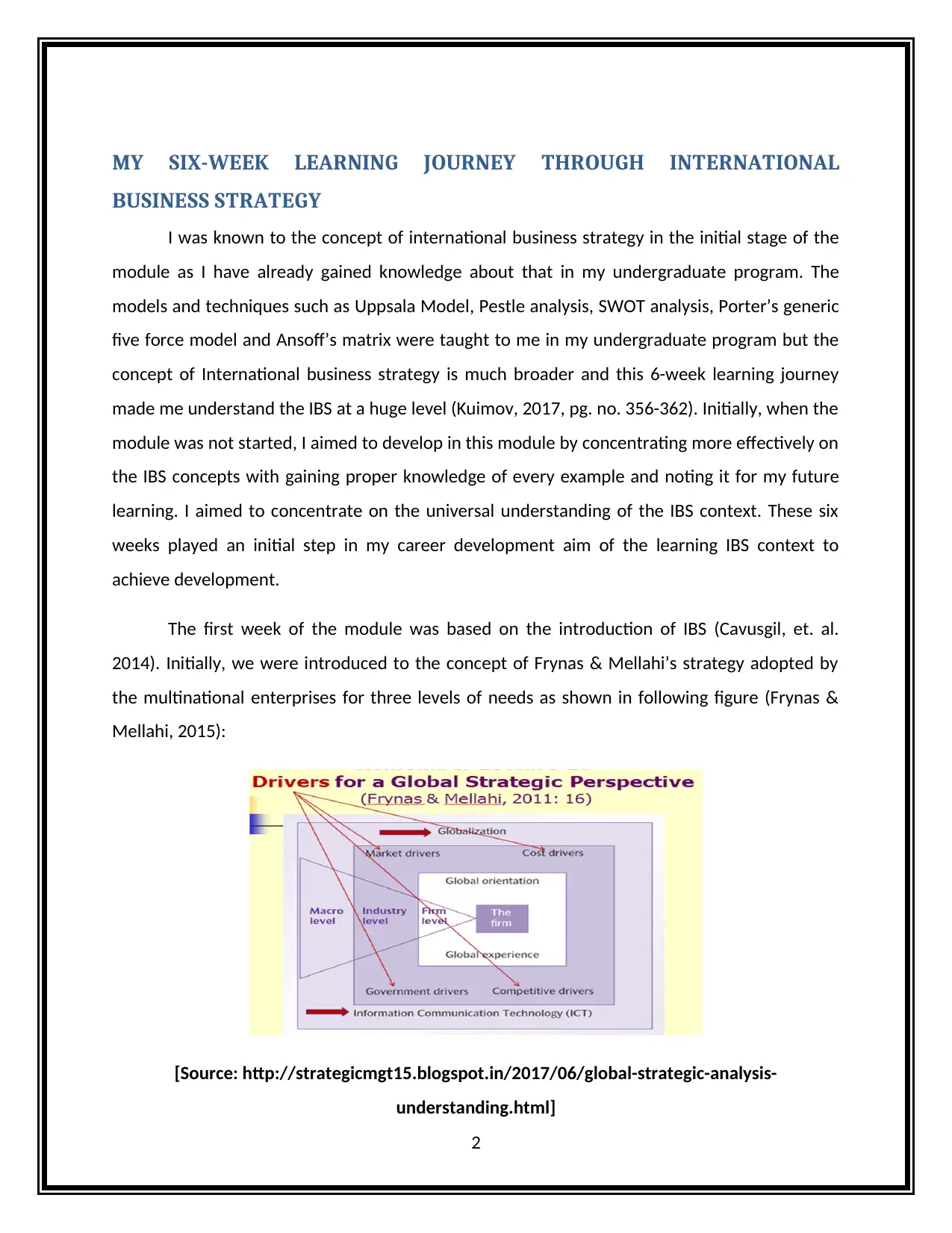
MY SIX-WEEK LEARNING JOURNEY THROUGH INTERNATIONAL
BUSINESS STRATEGY
I was known to the concept of international business strategy in the initial stage of the
module as I have already gained knowledge about that in my undergraduate program. The
models and techniques such as Uppsala Model, Pestle analysis, SWOT analysis, Porter’s generic
five force model and Ansoff’s matrix were taught to me in my undergraduate program but the
concept of International business strategy is much broader and this 6-week learning journey
made me understand the IBS at a huge level (Kuimov, 2017, pg. no. 356-362). Initially, when the
module was not started, I aimed to develop in this module by concentrating more effectively on
the IBS concepts with gaining proper knowledge of every example and noting it for my future
learning. I aimed to concentrate on the universal understanding of the IBS context. These six
weeks played an initial step in my career development aim of the learning IBS context to
achieve development.
The first week of the module was based on the introduction of IBS (Cavusgil, et. al.
2014). Initially, we were introduced to the concept of Frynas & Mellahi’s strategy adopted by
the multinational enterprises for three levels of needs as shown in following figure (Frynas &
Mellahi, 2015):
[Source: http://strategicmgt15.blogspot.in/2017/06/global-strategic-analysis-
understanding.html]
2
BUSINESS STRATEGY
I was known to the concept of international business strategy in the initial stage of the
module as I have already gained knowledge about that in my undergraduate program. The
models and techniques such as Uppsala Model, Pestle analysis, SWOT analysis, Porter’s generic
five force model and Ansoff’s matrix were taught to me in my undergraduate program but the
concept of International business strategy is much broader and this 6-week learning journey
made me understand the IBS at a huge level (Kuimov, 2017, pg. no. 356-362). Initially, when the
module was not started, I aimed to develop in this module by concentrating more effectively on
the IBS concepts with gaining proper knowledge of every example and noting it for my future
learning. I aimed to concentrate on the universal understanding of the IBS context. These six
weeks played an initial step in my career development aim of the learning IBS context to
achieve development.
The first week of the module was based on the introduction of IBS (Cavusgil, et. al.
2014). Initially, we were introduced to the concept of Frynas & Mellahi’s strategy adopted by
the multinational enterprises for three levels of needs as shown in following figure (Frynas &
Mellahi, 2015):
[Source: http://strategicmgt15.blogspot.in/2017/06/global-strategic-analysis-
understanding.html]
2
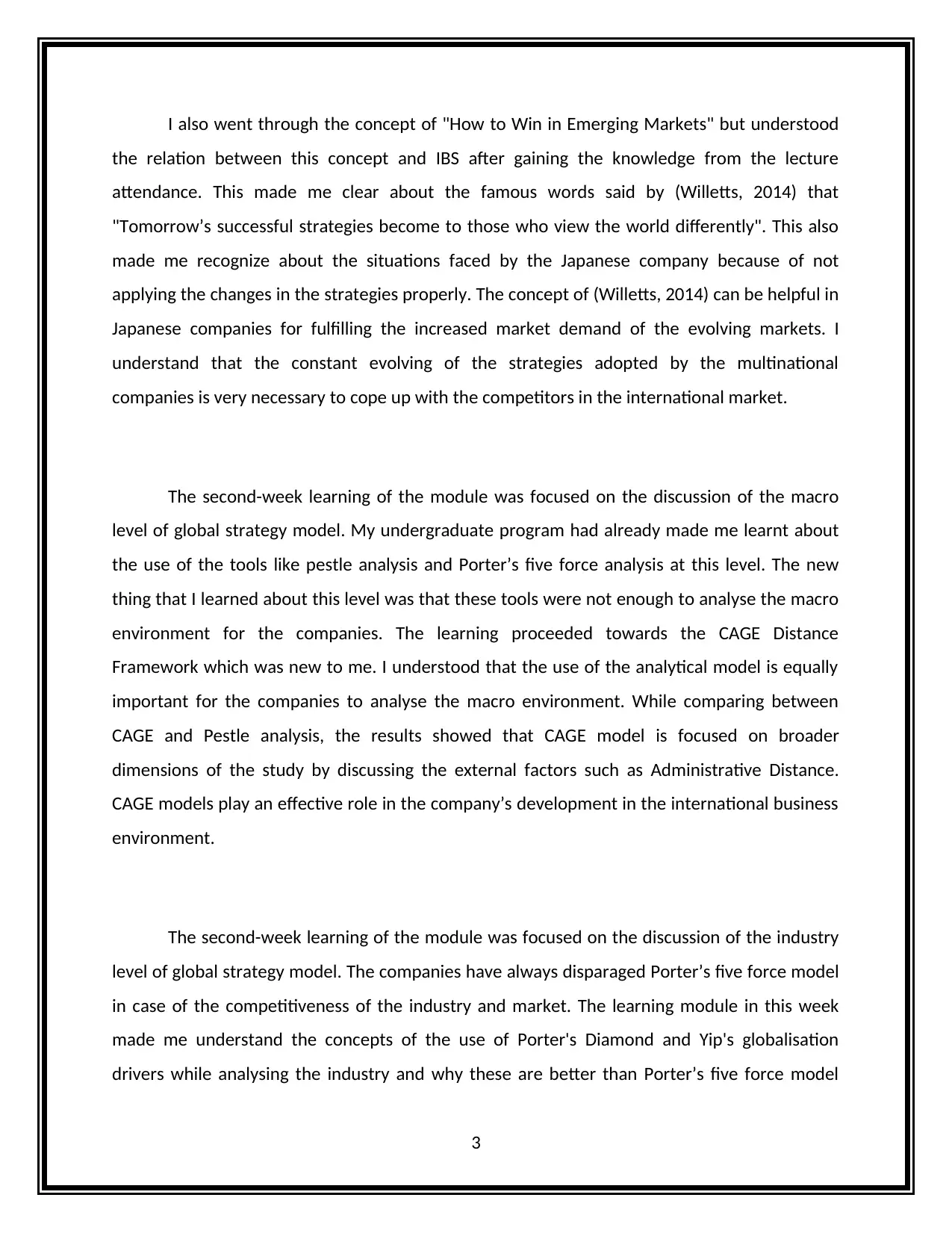
I also went through the concept of "How to Win in Emerging Markets" but understood
the relation between this concept and IBS after gaining the knowledge from the lecture
attendance. This made me clear about the famous words said by (Willetts, 2014) that
"Tomorrow’s successful strategies become to those who view the world differently". This also
made me recognize about the situations faced by the Japanese company because of not
applying the changes in the strategies properly. The concept of (Willetts, 2014) can be helpful in
Japanese companies for fulfilling the increased market demand of the evolving markets. I
understand that the constant evolving of the strategies adopted by the multinational
companies is very necessary to cope up with the competitors in the international market.
The second-week learning of the module was focused on the discussion of the macro
level of global strategy model. My undergraduate program had already made me learnt about
the use of the tools like pestle analysis and Porter’s five force analysis at this level. The new
thing that I learned about this level was that these tools were not enough to analyse the macro
environment for the companies. The learning proceeded towards the CAGE Distance
Framework which was new to me. I understood that the use of the analytical model is equally
important for the companies to analyse the macro environment. While comparing between
CAGE and Pestle analysis, the results showed that CAGE model is focused on broader
dimensions of the study by discussing the external factors such as Administrative Distance.
CAGE models play an effective role in the company’s development in the international business
environment.
The second-week learning of the module was focused on the discussion of the industry
level of global strategy model. The companies have always disparaged Porter’s five force model
in case of the competitiveness of the industry and market. The learning module in this week
made me understand the concepts of the use of Porter's Diamond and Yip's globalisation
drivers while analysing the industry and why these are better than Porter’s five force model
3
the relation between this concept and IBS after gaining the knowledge from the lecture
attendance. This made me clear about the famous words said by (Willetts, 2014) that
"Tomorrow’s successful strategies become to those who view the world differently". This also
made me recognize about the situations faced by the Japanese company because of not
applying the changes in the strategies properly. The concept of (Willetts, 2014) can be helpful in
Japanese companies for fulfilling the increased market demand of the evolving markets. I
understand that the constant evolving of the strategies adopted by the multinational
companies is very necessary to cope up with the competitors in the international market.
The second-week learning of the module was focused on the discussion of the macro
level of global strategy model. My undergraduate program had already made me learnt about
the use of the tools like pestle analysis and Porter’s five force analysis at this level. The new
thing that I learned about this level was that these tools were not enough to analyse the macro
environment for the companies. The learning proceeded towards the CAGE Distance
Framework which was new to me. I understood that the use of the analytical model is equally
important for the companies to analyse the macro environment. While comparing between
CAGE and Pestle analysis, the results showed that CAGE model is focused on broader
dimensions of the study by discussing the external factors such as Administrative Distance.
CAGE models play an effective role in the company’s development in the international business
environment.
The second-week learning of the module was focused on the discussion of the industry
level of global strategy model. The companies have always disparaged Porter’s five force model
in case of the competitiveness of the industry and market. The learning module in this week
made me understand the concepts of the use of Porter's Diamond and Yip's globalisation
drivers while analysing the industry and why these are better than Porter’s five force model
3

(Fainshmidt, et. al. 2016, pg. no. 81-104). The appendix 2 made me learn the same thing when I
read about the German company’s entry in the UK business market.
The third level firm level of the global strategy model was focused on the 4th week of the
module learning. The companies can base their strategies on the two contrasting approaches
namely inside-out perspective and outside-in perspective (Basham, et. al. 2016). Initially, I have
always considered that the analysis of the external market is enough for the company's market
development but this week made me learn about both the Strategic fit and Strategic stretch
which plays an efficient role in the company's development and making it achieve the global
success.
I was familiar with the entry mode strategies which were discussed in the 5th week. I was
more focused on gaining the knowledge about previous weeks’ learning. I also came to know
about the influence of the environmental factors on the company’s strategy for entering in the
new market. The interesting thing I learned in this week was about the market entry barriers
and their effects on the alignment of the companies. Beamish and Lupton’s (2009, Pages 648-
655) study made me understand about the combine working of the companies and creation of
the joint ventures for generating market value.
The last week of the learning module made me aware of the headquarter strategy. This
made me learns about the strategies and links between adaptation versus standardisation
strategies and between subsidiary level strategies (Dikova, et. al. 2017, pg. no. 405-435). Many
organizations are considered to adopt the global strategy but still, some of them are obligated
to follow a subsidiary's strategy for entering in a particular market for maintaining the
exceptionality of the market.
4
read about the German company’s entry in the UK business market.
The third level firm level of the global strategy model was focused on the 4th week of the
module learning. The companies can base their strategies on the two contrasting approaches
namely inside-out perspective and outside-in perspective (Basham, et. al. 2016). Initially, I have
always considered that the analysis of the external market is enough for the company's market
development but this week made me learn about both the Strategic fit and Strategic stretch
which plays an efficient role in the company's development and making it achieve the global
success.
I was familiar with the entry mode strategies which were discussed in the 5th week. I was
more focused on gaining the knowledge about previous weeks’ learning. I also came to know
about the influence of the environmental factors on the company’s strategy for entering in the
new market. The interesting thing I learned in this week was about the market entry barriers
and their effects on the alignment of the companies. Beamish and Lupton’s (2009, Pages 648-
655) study made me understand about the combine working of the companies and creation of
the joint ventures for generating market value.
The last week of the learning module made me aware of the headquarter strategy. This
made me learns about the strategies and links between adaptation versus standardisation
strategies and between subsidiary level strategies (Dikova, et. al. 2017, pg. no. 405-435). Many
organizations are considered to adopt the global strategy but still, some of them are obligated
to follow a subsidiary's strategy for entering in a particular market for maintaining the
exceptionality of the market.
4
Secure Best Marks with AI Grader
Need help grading? Try our AI Grader for instant feedback on your assignments.
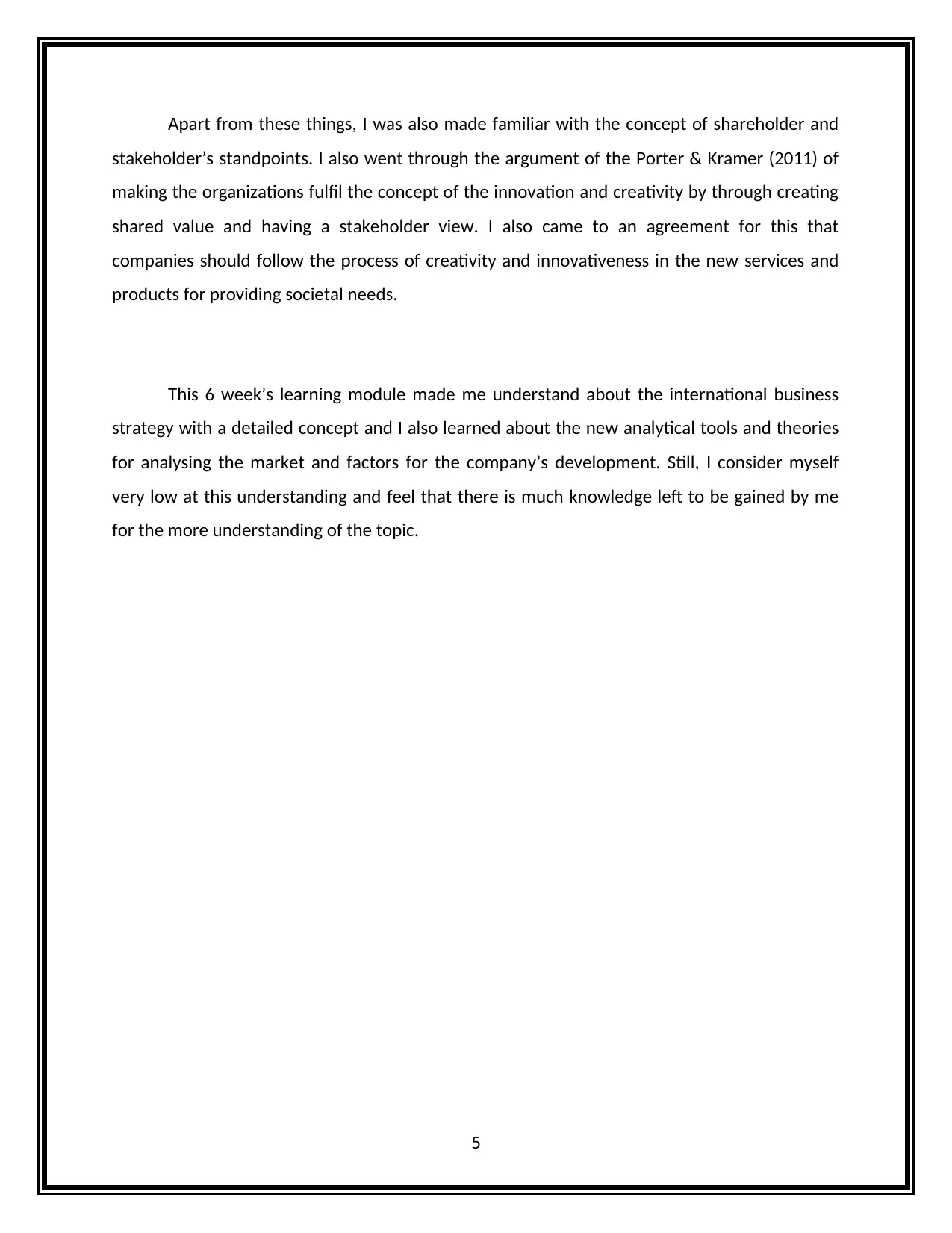
Apart from these things, I was also made familiar with the concept of shareholder and
stakeholder’s standpoints. I also went through the argument of the Porter & Kramer (2011) of
making the organizations fulfil the concept of the innovation and creativity by through creating
shared value and having a stakeholder view. I also came to an agreement for this that
companies should follow the process of creativity and innovativeness in the new services and
products for providing societal needs.
This 6 week’s learning module made me understand about the international business
strategy with a detailed concept and I also learned about the new analytical tools and theories
for analysing the market and factors for the company’s development. Still, I consider myself
very low at this understanding and feel that there is much knowledge left to be gained by me
for the more understanding of the topic.
5
stakeholder’s standpoints. I also went through the argument of the Porter & Kramer (2011) of
making the organizations fulfil the concept of the innovation and creativity by through creating
shared value and having a stakeholder view. I also came to an agreement for this that
companies should follow the process of creativity and innovativeness in the new services and
products for providing societal needs.
This 6 week’s learning module made me understand about the international business
strategy with a detailed concept and I also learned about the new analytical tools and theories
for analysing the market and factors for the company’s development. Still, I consider myself
very low at this understanding and feel that there is much knowledge left to be gained by me
for the more understanding of the topic.
5
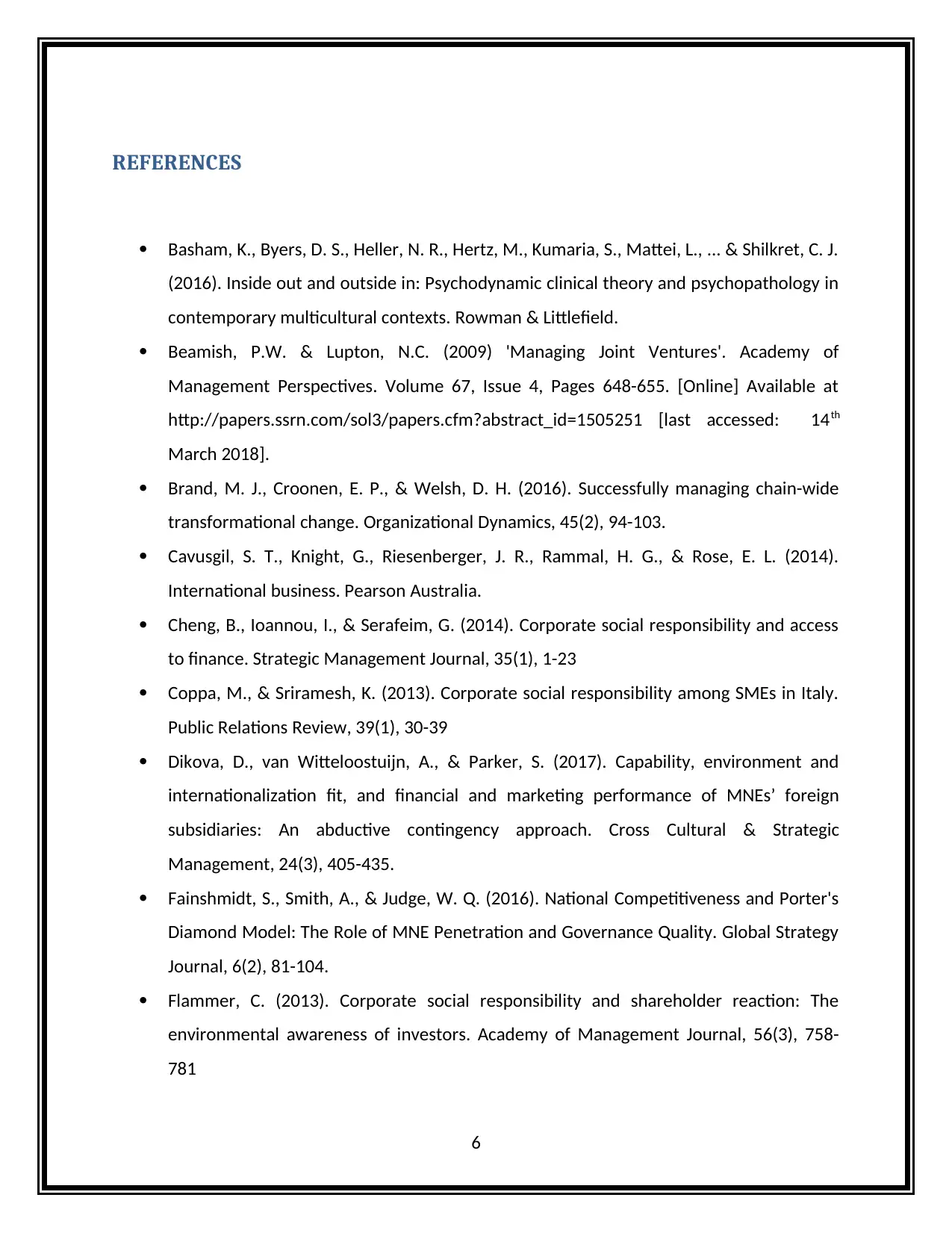
REFERENCES
Basham, K., Byers, D. S., Heller, N. R., Hertz, M., Kumaria, S., Mattei, L., ... & Shilkret, C. J.
(2016). Inside out and outside in: Psychodynamic clinical theory and psychopathology in
contemporary multicultural contexts. Rowman & Littlefield.
Beamish, P.W. & Lupton, N.C. (2009) 'Managing Joint Ventures'. Academy of
Management Perspectives. Volume 67, Issue 4, Pages 648-655. [Online] Available at
http://papers.ssrn.com/sol3/papers.cfm?abstract_id=1505251 [last accessed: 14th
March 2018].
Brand, M. J., Croonen, E. P., & Welsh, D. H. (2016). Successfully managing chain-wide
transformational change. Organizational Dynamics, 45(2), 94-103.
Cavusgil, S. T., Knight, G., Riesenberger, J. R., Rammal, H. G., & Rose, E. L. (2014).
International business. Pearson Australia.
Cheng, B., Ioannou, I., & Serafeim, G. (2014). Corporate social responsibility and access
to finance. Strategic Management Journal, 35(1), 1-23
Coppa, M., & Sriramesh, K. (2013). Corporate social responsibility among SMEs in Italy.
Public Relations Review, 39(1), 30-39
Dikova, D., van Witteloostuijn, A., & Parker, S. (2017). Capability, environment and
internationalization fit, and financial and marketing performance of MNEs’ foreign
subsidiaries: An abductive contingency approach. Cross Cultural & Strategic
Management, 24(3), 405-435.
Fainshmidt, S., Smith, A., & Judge, W. Q. (2016). National Competitiveness and Porter's
Diamond Model: The Role of MNE Penetration and Governance Quality. Global Strategy
Journal, 6(2), 81-104.
Flammer, C. (2013). Corporate social responsibility and shareholder reaction: The
environmental awareness of investors. Academy of Management Journal, 56(3), 758-
781
6
Basham, K., Byers, D. S., Heller, N. R., Hertz, M., Kumaria, S., Mattei, L., ... & Shilkret, C. J.
(2016). Inside out and outside in: Psychodynamic clinical theory and psychopathology in
contemporary multicultural contexts. Rowman & Littlefield.
Beamish, P.W. & Lupton, N.C. (2009) 'Managing Joint Ventures'. Academy of
Management Perspectives. Volume 67, Issue 4, Pages 648-655. [Online] Available at
http://papers.ssrn.com/sol3/papers.cfm?abstract_id=1505251 [last accessed: 14th
March 2018].
Brand, M. J., Croonen, E. P., & Welsh, D. H. (2016). Successfully managing chain-wide
transformational change. Organizational Dynamics, 45(2), 94-103.
Cavusgil, S. T., Knight, G., Riesenberger, J. R., Rammal, H. G., & Rose, E. L. (2014).
International business. Pearson Australia.
Cheng, B., Ioannou, I., & Serafeim, G. (2014). Corporate social responsibility and access
to finance. Strategic Management Journal, 35(1), 1-23
Coppa, M., & Sriramesh, K. (2013). Corporate social responsibility among SMEs in Italy.
Public Relations Review, 39(1), 30-39
Dikova, D., van Witteloostuijn, A., & Parker, S. (2017). Capability, environment and
internationalization fit, and financial and marketing performance of MNEs’ foreign
subsidiaries: An abductive contingency approach. Cross Cultural & Strategic
Management, 24(3), 405-435.
Fainshmidt, S., Smith, A., & Judge, W. Q. (2016). National Competitiveness and Porter's
Diamond Model: The Role of MNE Penetration and Governance Quality. Global Strategy
Journal, 6(2), 81-104.
Flammer, C. (2013). Corporate social responsibility and shareholder reaction: The
environmental awareness of investors. Academy of Management Journal, 56(3), 758-
781
6

Frynas, J. G., & Mellahi, K. (2015). Global strategic management. Oxford University
Press, USA.
Kuimov, V. (2017). A Contextual-Functional Analysis of the Enterprise Performance.
International Journal of Entrepreneurial Behavior & Research, 23(2), 356-362.
McKenny, A. F., Allison, T. H., Ketchen, D. J., Short, J. C., & Ireland, R. D. (2017). How
Should Crowdfunding Research Evolve? A Survey of the Entrepreneurship Theory and
Practice Editorial Board. Entrepreneurship Theory and Practice, 41(2), 291-304.
Mofuoa, K. (2016). The Normative Grounding of Social Responsibility in African
Emerging Markets: A Setho Ethics Approach. In Ethical and Social Perspectives on Global
Business Interaction in Emerging Markets (pp. 97-115). IGI Global
Peet, R., & Hartwick, E. (2015). Theories of development: Contentions, arguments,
alternatives. Guilford Publications.
Wild, J. J., Wild, K. L., & Han, J. C. (2014). International business. Pearson Education
Limited.
Willetts, J. (2014) International Business Strategy Perspectives. PowerPoint slides, week
1. Hertfordshire Business School. 6/10-2014.
7
Press, USA.
Kuimov, V. (2017). A Contextual-Functional Analysis of the Enterprise Performance.
International Journal of Entrepreneurial Behavior & Research, 23(2), 356-362.
McKenny, A. F., Allison, T. H., Ketchen, D. J., Short, J. C., & Ireland, R. D. (2017). How
Should Crowdfunding Research Evolve? A Survey of the Entrepreneurship Theory and
Practice Editorial Board. Entrepreneurship Theory and Practice, 41(2), 291-304.
Mofuoa, K. (2016). The Normative Grounding of Social Responsibility in African
Emerging Markets: A Setho Ethics Approach. In Ethical and Social Perspectives on Global
Business Interaction in Emerging Markets (pp. 97-115). IGI Global
Peet, R., & Hartwick, E. (2015). Theories of development: Contentions, arguments,
alternatives. Guilford Publications.
Wild, J. J., Wild, K. L., & Han, J. C. (2014). International business. Pearson Education
Limited.
Willetts, J. (2014) International Business Strategy Perspectives. PowerPoint slides, week
1. Hertfordshire Business School. 6/10-2014.
7
Paraphrase This Document
Need a fresh take? Get an instant paraphrase of this document with our AI Paraphraser
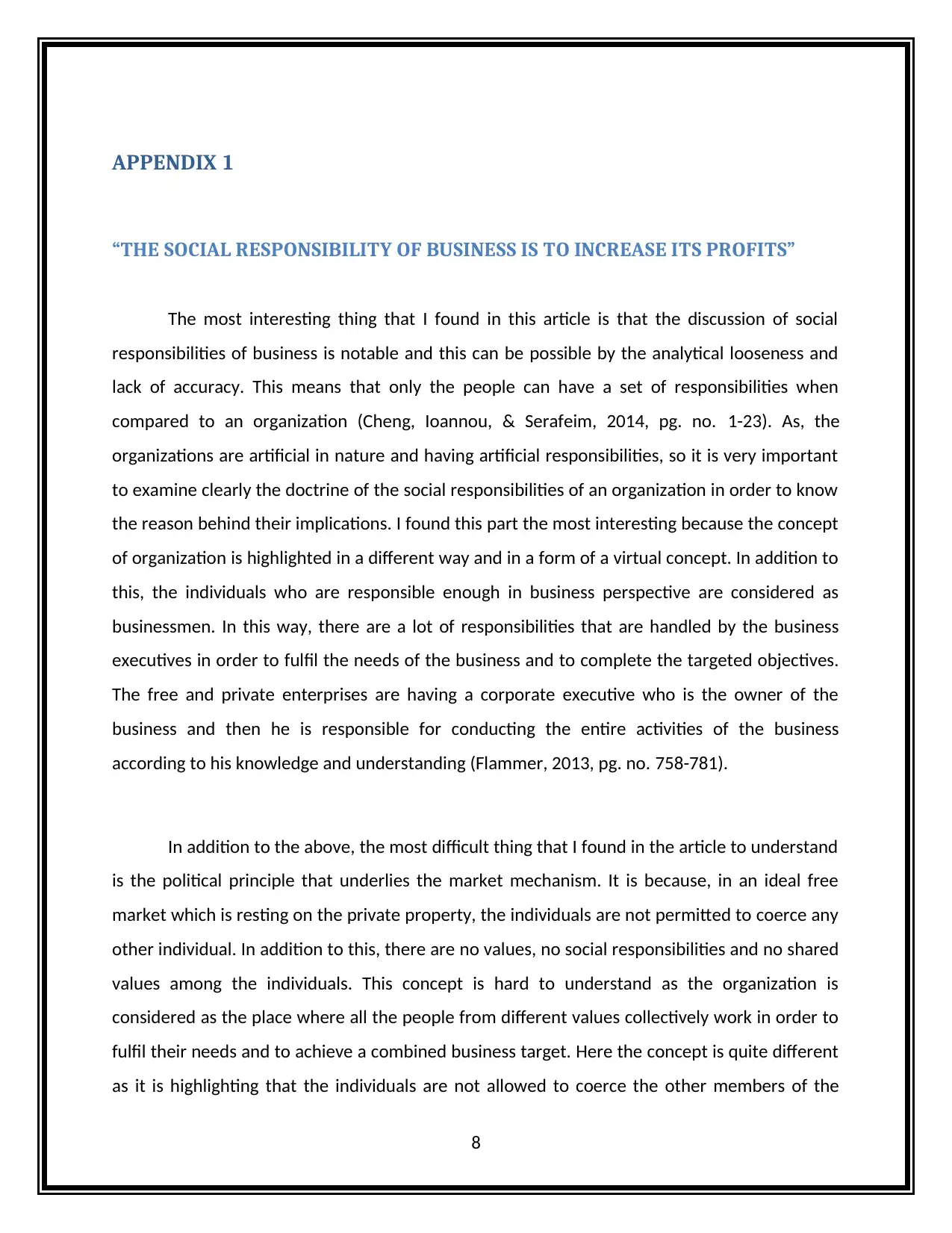
APPENDIX 1
“THE SOCIAL RESPONSIBILITY OF BUSINESS IS TO INCREASE ITS PROFITS”
The most interesting thing that I found in this article is that the discussion of social
responsibilities of business is notable and this can be possible by the analytical looseness and
lack of accuracy. This means that only the people can have a set of responsibilities when
compared to an organization (Cheng, Ioannou, & Serafeim, 2014, pg. no. 1-23). As, the
organizations are artificial in nature and having artificial responsibilities, so it is very important
to examine clearly the doctrine of the social responsibilities of an organization in order to know
the reason behind their implications. I found this part the most interesting because the concept
of organization is highlighted in a different way and in a form of a virtual concept. In addition to
this, the individuals who are responsible enough in business perspective are considered as
businessmen. In this way, there are a lot of responsibilities that are handled by the business
executives in order to fulfil the needs of the business and to complete the targeted objectives.
The free and private enterprises are having a corporate executive who is the owner of the
business and then he is responsible for conducting the entire activities of the business
according to his knowledge and understanding (Flammer, 2013, pg. no. 758-781).
In addition to the above, the most difficult thing that I found in the article to understand
is the political principle that underlies the market mechanism. It is because, in an ideal free
market which is resting on the private property, the individuals are not permitted to coerce any
other individual. In addition to this, there are no values, no social responsibilities and no shared
values among the individuals. This concept is hard to understand as the organization is
considered as the place where all the people from different values collectively work in order to
fulfil their needs and to achieve a combined business target. Here the concept is quite different
as it is highlighting that the individuals are not allowed to coerce the other members of the
8
“THE SOCIAL RESPONSIBILITY OF BUSINESS IS TO INCREASE ITS PROFITS”
The most interesting thing that I found in this article is that the discussion of social
responsibilities of business is notable and this can be possible by the analytical looseness and
lack of accuracy. This means that only the people can have a set of responsibilities when
compared to an organization (Cheng, Ioannou, & Serafeim, 2014, pg. no. 1-23). As, the
organizations are artificial in nature and having artificial responsibilities, so it is very important
to examine clearly the doctrine of the social responsibilities of an organization in order to know
the reason behind their implications. I found this part the most interesting because the concept
of organization is highlighted in a different way and in a form of a virtual concept. In addition to
this, the individuals who are responsible enough in business perspective are considered as
businessmen. In this way, there are a lot of responsibilities that are handled by the business
executives in order to fulfil the needs of the business and to complete the targeted objectives.
The free and private enterprises are having a corporate executive who is the owner of the
business and then he is responsible for conducting the entire activities of the business
according to his knowledge and understanding (Flammer, 2013, pg. no. 758-781).
In addition to the above, the most difficult thing that I found in the article to understand
is the political principle that underlies the market mechanism. It is because, in an ideal free
market which is resting on the private property, the individuals are not permitted to coerce any
other individual. In addition to this, there are no values, no social responsibilities and no shared
values among the individuals. This concept is hard to understand as the organization is
considered as the place where all the people from different values collectively work in order to
fulfil their needs and to achieve a combined business target. Here the concept is quite different
as it is highlighting that the individuals are not allowed to coerce the other members of the
8
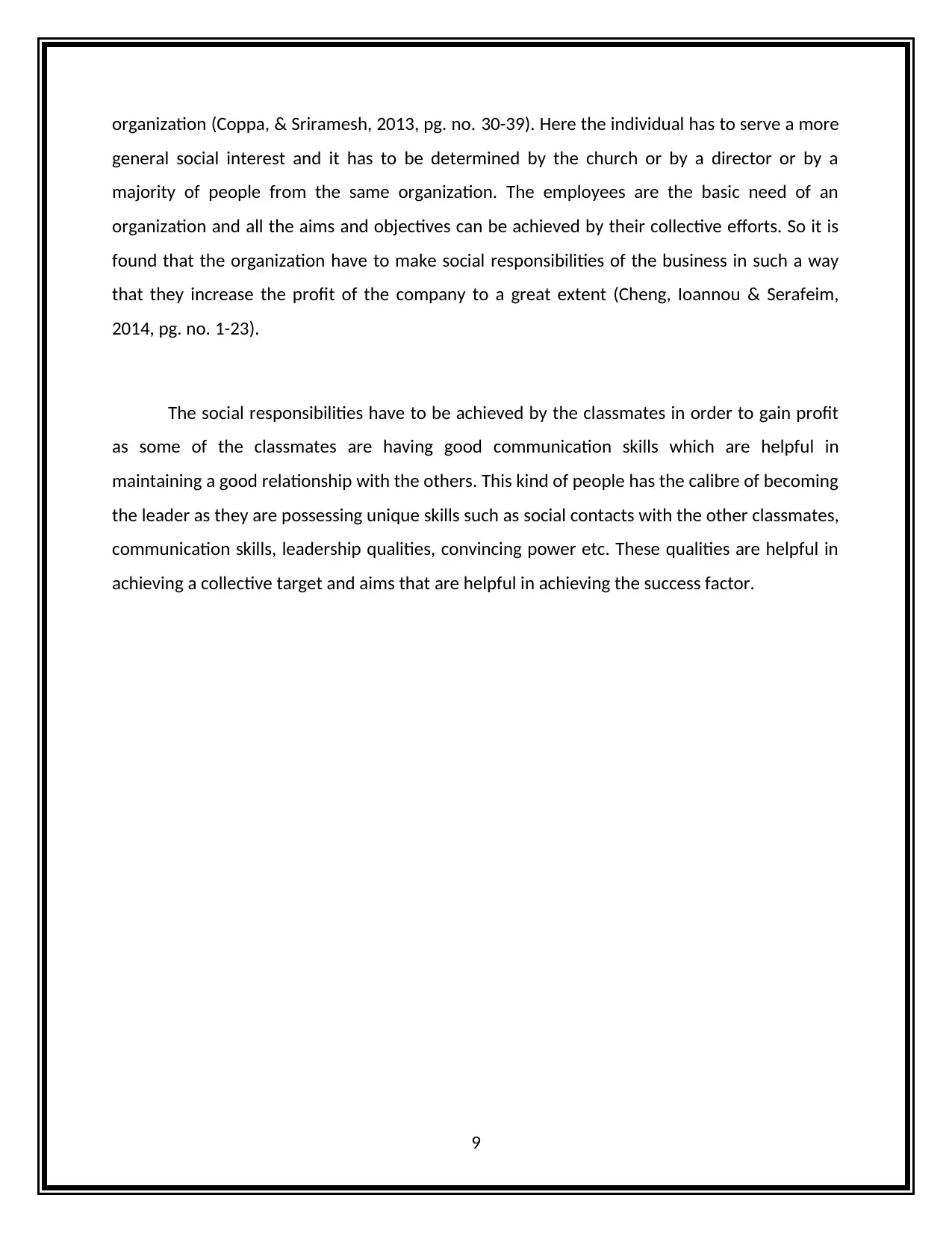
organization (Coppa, & Sriramesh, 2013, pg. no. 30-39). Here the individual has to serve a more
general social interest and it has to be determined by the church or by a director or by a
majority of people from the same organization. The employees are the basic need of an
organization and all the aims and objectives can be achieved by their collective efforts. So it is
found that the organization have to make social responsibilities of the business in such a way
that they increase the profit of the company to a great extent (Cheng, Ioannou & Serafeim,
2014, pg. no. 1-23).
The social responsibilities have to be achieved by the classmates in order to gain profit
as some of the classmates are having good communication skills which are helpful in
maintaining a good relationship with the others. This kind of people has the calibre of becoming
the leader as they are possessing unique skills such as social contacts with the other classmates,
communication skills, leadership qualities, convincing power etc. These qualities are helpful in
achieving a collective target and aims that are helpful in achieving the success factor.
9
general social interest and it has to be determined by the church or by a director or by a
majority of people from the same organization. The employees are the basic need of an
organization and all the aims and objectives can be achieved by their collective efforts. So it is
found that the organization have to make social responsibilities of the business in such a way
that they increase the profit of the company to a great extent (Cheng, Ioannou & Serafeim,
2014, pg. no. 1-23).
The social responsibilities have to be achieved by the classmates in order to gain profit
as some of the classmates are having good communication skills which are helpful in
maintaining a good relationship with the others. This kind of people has the calibre of becoming
the leader as they are possessing unique skills such as social contacts with the other classmates,
communication skills, leadership qualities, convincing power etc. These qualities are helpful in
achieving a collective target and aims that are helpful in achieving the success factor.
9
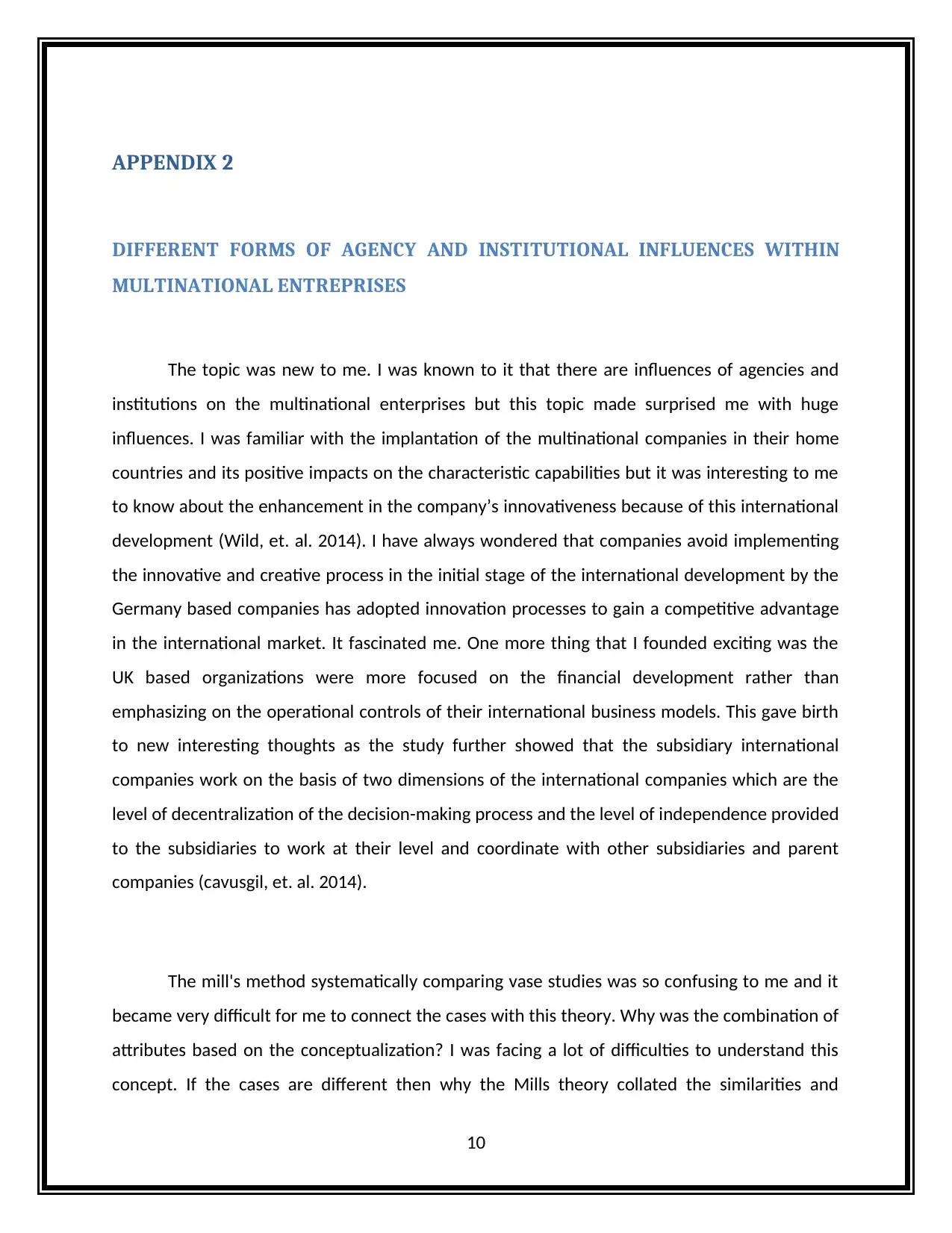
APPENDIX 2
DIFFERENT FORMS OF AGENCY AND INSTITUTIONAL INFLUENCES WITHIN
MULTINATIONAL ENTREPRISES
The topic was new to me. I was known to it that there are influences of agencies and
institutions on the multinational enterprises but this topic made surprised me with huge
influences. I was familiar with the implantation of the multinational companies in their home
countries and its positive impacts on the characteristic capabilities but it was interesting to me
to know about the enhancement in the company’s innovativeness because of this international
development (Wild, et. al. 2014). I have always wondered that companies avoid implementing
the innovative and creative process in the initial stage of the international development by the
Germany based companies has adopted innovation processes to gain a competitive advantage
in the international market. It fascinated me. One more thing that I founded exciting was the
UK based organizations were more focused on the financial development rather than
emphasizing on the operational controls of their international business models. This gave birth
to new interesting thoughts as the study further showed that the subsidiary international
companies work on the basis of two dimensions of the international companies which are the
level of decentralization of the decision-making process and the level of independence provided
to the subsidiaries to work at their level and coordinate with other subsidiaries and parent
companies (cavusgil, et. al. 2014).
The mill's method systematically comparing vase studies was so confusing to me and it
became very difficult for me to connect the cases with this theory. Why was the combination of
attributes based on the conceptualization? I was facing a lot of difficulties to understand this
concept. If the cases are different then why the Mills theory collated the similarities and
10
DIFFERENT FORMS OF AGENCY AND INSTITUTIONAL INFLUENCES WITHIN
MULTINATIONAL ENTREPRISES
The topic was new to me. I was known to it that there are influences of agencies and
institutions on the multinational enterprises but this topic made surprised me with huge
influences. I was familiar with the implantation of the multinational companies in their home
countries and its positive impacts on the characteristic capabilities but it was interesting to me
to know about the enhancement in the company’s innovativeness because of this international
development (Wild, et. al. 2014). I have always wondered that companies avoid implementing
the innovative and creative process in the initial stage of the international development by the
Germany based companies has adopted innovation processes to gain a competitive advantage
in the international market. It fascinated me. One more thing that I founded exciting was the
UK based organizations were more focused on the financial development rather than
emphasizing on the operational controls of their international business models. This gave birth
to new interesting thoughts as the study further showed that the subsidiary international
companies work on the basis of two dimensions of the international companies which are the
level of decentralization of the decision-making process and the level of independence provided
to the subsidiaries to work at their level and coordinate with other subsidiaries and parent
companies (cavusgil, et. al. 2014).
The mill's method systematically comparing vase studies was so confusing to me and it
became very difficult for me to connect the cases with this theory. Why was the combination of
attributes based on the conceptualization? I was facing a lot of difficulties to understand this
concept. If the cases are different then why the Mills theory collated the similarities and
10
Secure Best Marks with AI Grader
Need help grading? Try our AI Grader for instant feedback on your assignments.
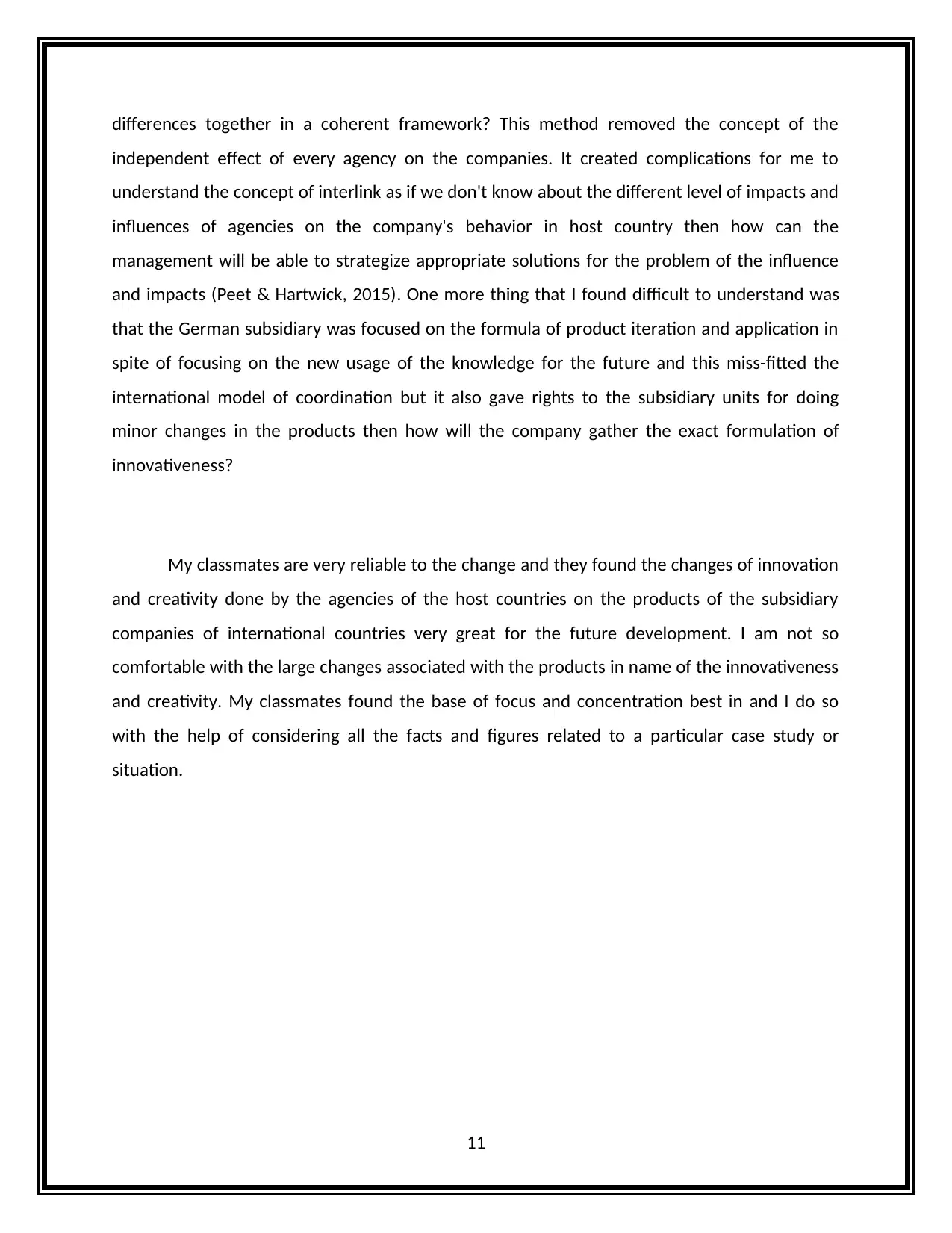
differences together in a coherent framework? This method removed the concept of the
independent effect of every agency on the companies. It created complications for me to
understand the concept of interlink as if we don't know about the different level of impacts and
influences of agencies on the company's behavior in host country then how can the
management will be able to strategize appropriate solutions for the problem of the influence
and impacts (Peet & Hartwick, 2015). One more thing that I found difficult to understand was
that the German subsidiary was focused on the formula of product iteration and application in
spite of focusing on the new usage of the knowledge for the future and this miss-fitted the
international model of coordination but it also gave rights to the subsidiary units for doing
minor changes in the products then how will the company gather the exact formulation of
innovativeness?
My classmates are very reliable to the change and they found the changes of innovation
and creativity done by the agencies of the host countries on the products of the subsidiary
companies of international countries very great for the future development. I am not so
comfortable with the large changes associated with the products in name of the innovativeness
and creativity. My classmates found the base of focus and concentration best in and I do so
with the help of considering all the facts and figures related to a particular case study or
situation.
11
independent effect of every agency on the companies. It created complications for me to
understand the concept of interlink as if we don't know about the different level of impacts and
influences of agencies on the company's behavior in host country then how can the
management will be able to strategize appropriate solutions for the problem of the influence
and impacts (Peet & Hartwick, 2015). One more thing that I found difficult to understand was
that the German subsidiary was focused on the formula of product iteration and application in
spite of focusing on the new usage of the knowledge for the future and this miss-fitted the
international model of coordination but it also gave rights to the subsidiary units for doing
minor changes in the products then how will the company gather the exact formulation of
innovativeness?
My classmates are very reliable to the change and they found the changes of innovation
and creativity done by the agencies of the host countries on the products of the subsidiary
companies of international countries very great for the future development. I am not so
comfortable with the large changes associated with the products in name of the innovativeness
and creativity. My classmates found the base of focus and concentration best in and I do so
with the help of considering all the facts and figures related to a particular case study or
situation.
11
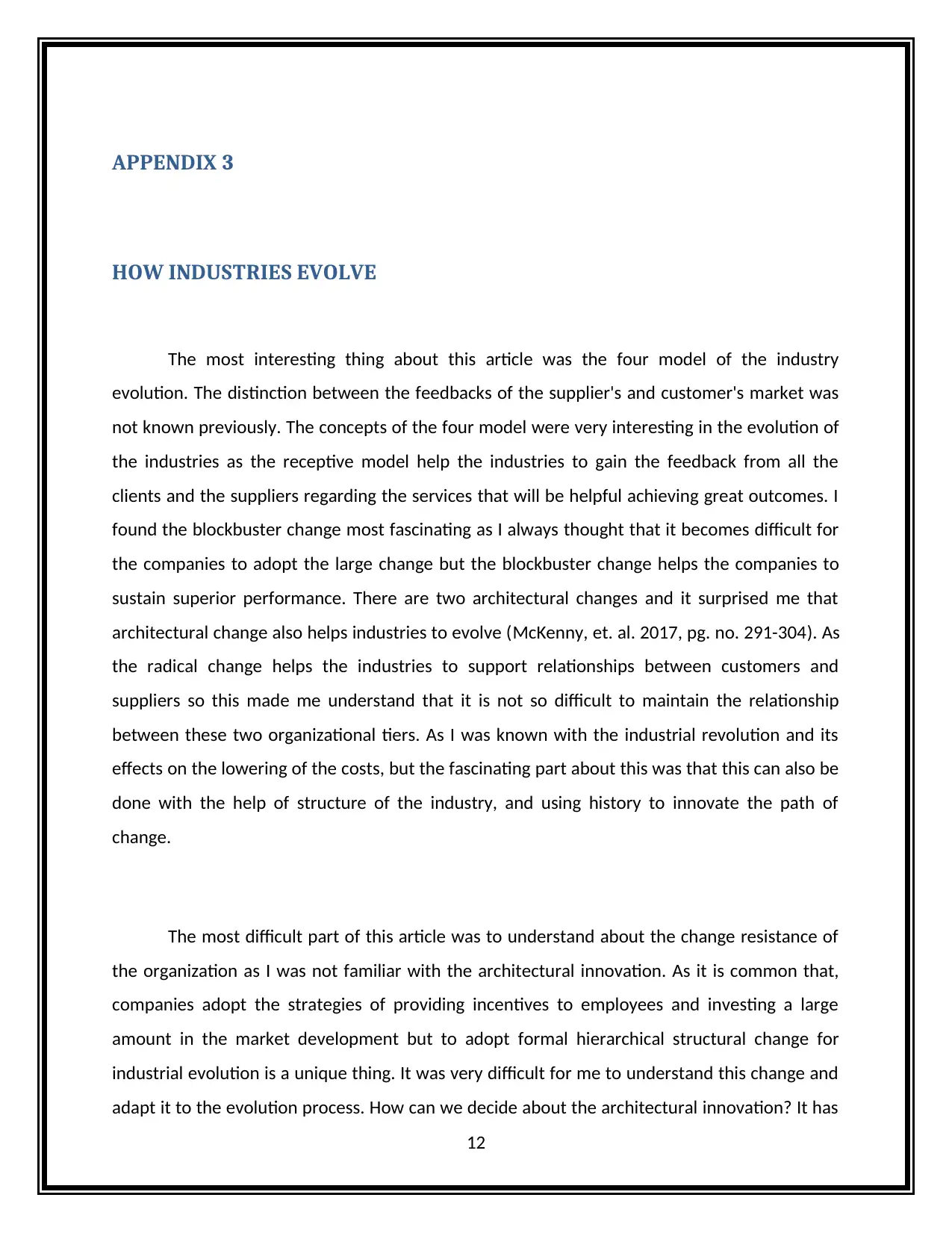
APPENDIX 3
HOW INDUSTRIES EVOLVE
The most interesting thing about this article was the four model of the industry
evolution. The distinction between the feedbacks of the supplier's and customer's market was
not known previously. The concepts of the four model were very interesting in the evolution of
the industries as the receptive model help the industries to gain the feedback from all the
clients and the suppliers regarding the services that will be helpful achieving great outcomes. I
found the blockbuster change most fascinating as I always thought that it becomes difficult for
the companies to adopt the large change but the blockbuster change helps the companies to
sustain superior performance. There are two architectural changes and it surprised me that
architectural change also helps industries to evolve (McKenny, et. al. 2017, pg. no. 291-304). As
the radical change helps the industries to support relationships between customers and
suppliers so this made me understand that it is not so difficult to maintain the relationship
between these two organizational tiers. As I was known with the industrial revolution and its
effects on the lowering of the costs, but the fascinating part about this was that this can also be
done with the help of structure of the industry, and using history to innovate the path of
change.
The most difficult part of this article was to understand about the change resistance of
the organization as I was not familiar with the architectural innovation. As it is common that,
companies adopt the strategies of providing incentives to employees and investing a large
amount in the market development but to adopt formal hierarchical structural change for
industrial evolution is a unique thing. It was very difficult for me to understand this change and
adapt it to the evolution process. How can we decide about the architectural innovation? It has
12
HOW INDUSTRIES EVOLVE
The most interesting thing about this article was the four model of the industry
evolution. The distinction between the feedbacks of the supplier's and customer's market was
not known previously. The concepts of the four model were very interesting in the evolution of
the industries as the receptive model help the industries to gain the feedback from all the
clients and the suppliers regarding the services that will be helpful achieving great outcomes. I
found the blockbuster change most fascinating as I always thought that it becomes difficult for
the companies to adopt the large change but the blockbuster change helps the companies to
sustain superior performance. There are two architectural changes and it surprised me that
architectural change also helps industries to evolve (McKenny, et. al. 2017, pg. no. 291-304). As
the radical change helps the industries to support relationships between customers and
suppliers so this made me understand that it is not so difficult to maintain the relationship
between these two organizational tiers. As I was known with the industrial revolution and its
effects on the lowering of the costs, but the fascinating part about this was that this can also be
done with the help of structure of the industry, and using history to innovate the path of
change.
The most difficult part of this article was to understand about the change resistance of
the organization as I was not familiar with the architectural innovation. As it is common that,
companies adopt the strategies of providing incentives to employees and investing a large
amount in the market development but to adopt formal hierarchical structural change for
industrial evolution is a unique thing. It was very difficult for me to understand this change and
adapt it to the evolution process. How can we decide about the architectural innovation? It has
12
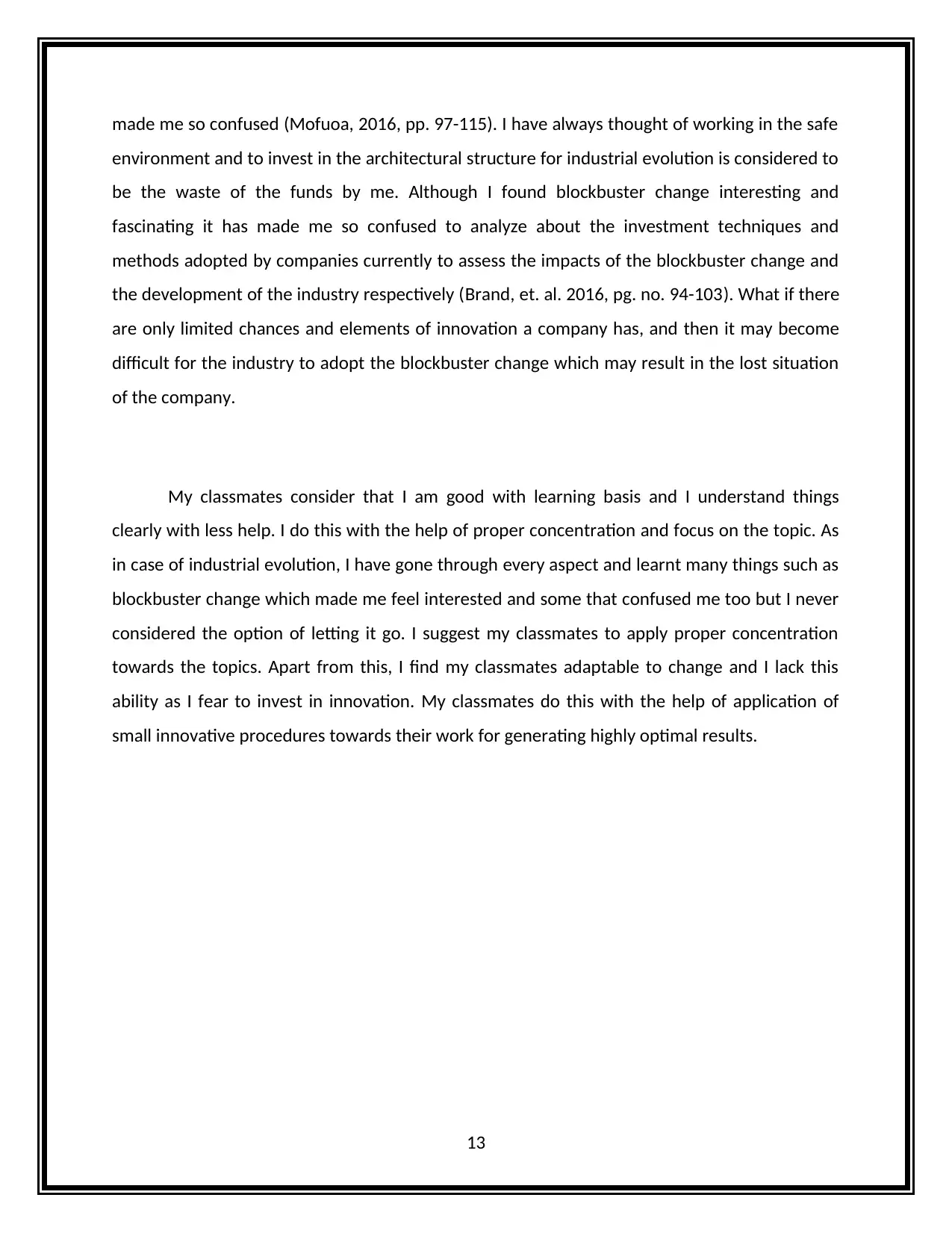
made me so confused (Mofuoa, 2016, pp. 97-115). I have always thought of working in the safe
environment and to invest in the architectural structure for industrial evolution is considered to
be the waste of the funds by me. Although I found blockbuster change interesting and
fascinating it has made me so confused to analyze about the investment techniques and
methods adopted by companies currently to assess the impacts of the blockbuster change and
the development of the industry respectively (Brand, et. al. 2016, pg. no. 94-103). What if there
are only limited chances and elements of innovation a company has, and then it may become
difficult for the industry to adopt the blockbuster change which may result in the lost situation
of the company.
My classmates consider that I am good with learning basis and I understand things
clearly with less help. I do this with the help of proper concentration and focus on the topic. As
in case of industrial evolution, I have gone through every aspect and learnt many things such as
blockbuster change which made me feel interested and some that confused me too but I never
considered the option of letting it go. I suggest my classmates to apply proper concentration
towards the topics. Apart from this, I find my classmates adaptable to change and I lack this
ability as I fear to invest in innovation. My classmates do this with the help of application of
small innovative procedures towards their work for generating highly optimal results.
13
environment and to invest in the architectural structure for industrial evolution is considered to
be the waste of the funds by me. Although I found blockbuster change interesting and
fascinating it has made me so confused to analyze about the investment techniques and
methods adopted by companies currently to assess the impacts of the blockbuster change and
the development of the industry respectively (Brand, et. al. 2016, pg. no. 94-103). What if there
are only limited chances and elements of innovation a company has, and then it may become
difficult for the industry to adopt the blockbuster change which may result in the lost situation
of the company.
My classmates consider that I am good with learning basis and I understand things
clearly with less help. I do this with the help of proper concentration and focus on the topic. As
in case of industrial evolution, I have gone through every aspect and learnt many things such as
blockbuster change which made me feel interested and some that confused me too but I never
considered the option of letting it go. I suggest my classmates to apply proper concentration
towards the topics. Apart from this, I find my classmates adaptable to change and I lack this
ability as I fear to invest in innovation. My classmates do this with the help of application of
small innovative procedures towards their work for generating highly optimal results.
13
1 out of 13
Your All-in-One AI-Powered Toolkit for Academic Success.
+13062052269
info@desklib.com
Available 24*7 on WhatsApp / Email
![[object Object]](/_next/static/media/star-bottom.7253800d.svg)
Unlock your academic potential
© 2024 | Zucol Services PVT LTD | All rights reserved.
